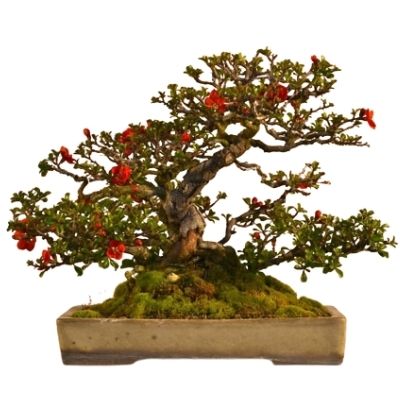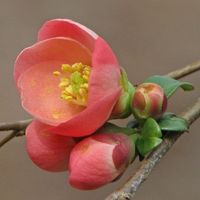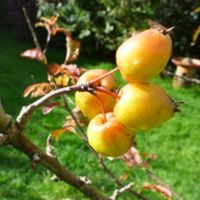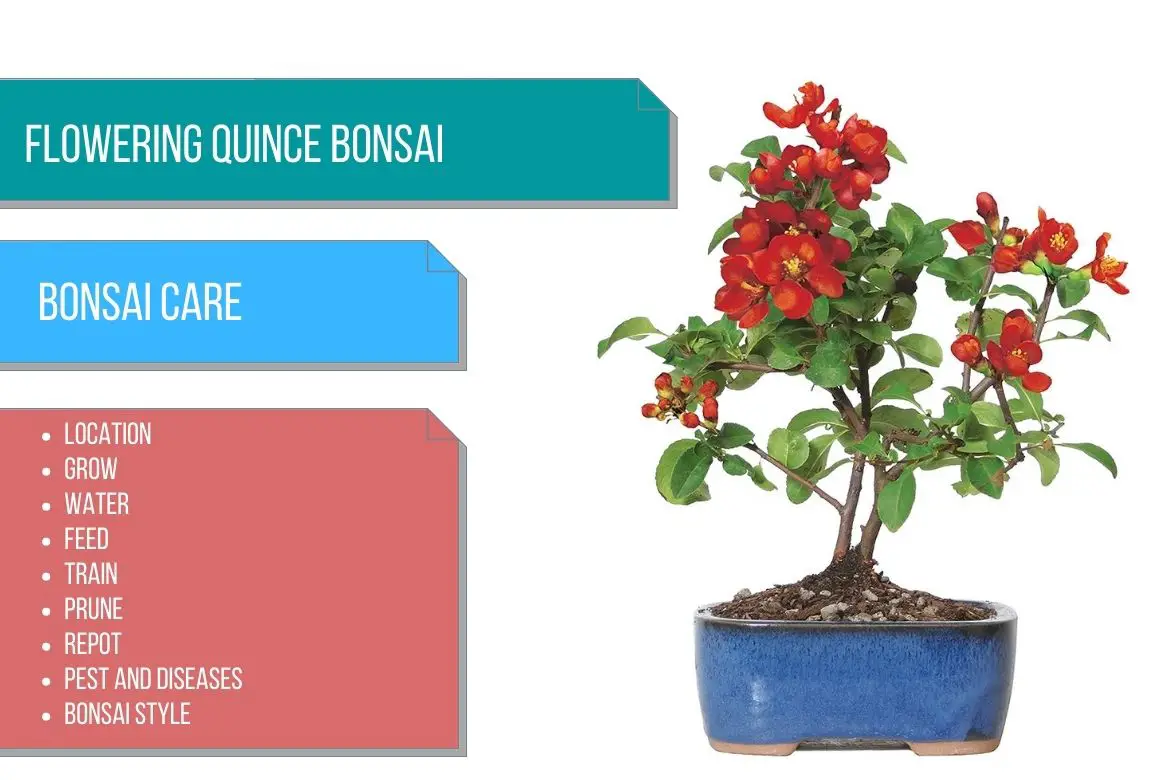
Flowering Quince
(Chaenomeles)
Country of Origin : Japan
Bonsai Styles : Informal upright, clump
Zone : 5 – 9
Flowering quinces, native to China and Japan, are some of the best and easiest spring flowering bonsai plants to grow.
Early in the spring, they bloom in a variety of colors, including white, pink, orange, and red.
This shrub grows well in temperate climates, and its branches and spurs are particularly attractive due to their profuse blooming in late winter and early spring, just before the leaves appear.
The flowering quince is a medium-sized shrub that propagates by suckers.
Quince are sometimes also called as “single-season” bonsai since they require complete pruning to promote flowering.
This habit of growing a new trunk from root suckers makes this plant one of the ideal candidates for commercial bonsai growers and bonsai enthusiasts to grow clump style flowering quince bonsai tree. However, on the other hand, training a Chaenomeles bonsai tree in a single trunk style in a pot is equally difficult.
Many bonsai enthusiasts raise the roots of the quince bonsai tree giving it an interesting impression of mimicking a riverside tree which has its roots exposed.
Plants that have grown in the ground for several years are lifted and planted in pots with large roots exposed at the top. This also reveals the places from which suckers grow. Only a few are chosen for training into trunks, while the rest are trimmed.
It is a thorny, deciduous, spreading shrub that grows to about 3 feet in height.
Some of the common varieties of Chaenomeles are:
- Chaenomeles speciosa – Also known as Chinese flowering quince. This variety Chaenomeles speciosa ‘Nivalis’ is specially good for creating flowering quince bonsai tree. It has white flowers.
- Chaenomeles superba – Chaenomeles superba ‘Etna’ has rich vivid reddish orange flowers. Chaenomeles superba ‘Pink Lady’ has rose pink flowers.
- Chaenomeles japonica – It is also known as Japanese quince. This flowering quince variety bears red flowers. It also has a dwarf variety – Chaenomeles japonica ‘Chojubai‘, which produces small white or red flowers throughout the year.

Mid-green, ovate to round leaves of flowering quince tree. The branch might also have few thorns.

Flowers are borne on older wood from early spring to late summer, and are orange-red, scarlet, or crimson in color. The flowers of flowering quince resemble the flowers of apple tree.

A yellow apple-shaped fruit, with a slight red color tinge sometimes, follows the flowering stage.
Best location to keep Flowering Quince Bonsai
Flowering quince bonsai tree grows well in full sunlight or semi-shade through out the growing season.
In hot summer days, it’s a wise idea to provide the quince tree with some shade. As quince is not drought tolerant, this practice will prevent the bonsai soil mix from losing moisture.
Flowering quince bonsai tree is also very hardy and hence it doesn’t need any special winter care.
Provide plenty of sunshine for the bonsai tree during the day to encourage earlier blooming. Make sure the bonsai tree is kept in temperatures above 23 °F (-5 °C) at night.
However, in some cases flowing quince bonsai has survived temperatures way lower than the temperature range mentioned above.
Propagation Flowering Quince
Flowering quince can be grown via seeds by sowing the seeds in early spring. The quince seed germinates quite rapidly.
Quince tree can also be propagated using softwood cuttings in midsummer.
Quince tree can be propagated using hardwood cuttings in winter. Using a hardwood cutting to propagate a quince tree will produce a tree much faster (almost in an year).
Quince plant can be propagated via root division as well, particularly by using the dwarf varieties of flowering quince bonsai trees.
Grafting is also used specially in the case of named varieties such as Chaenomeles japonica.
Watering Flowering Quince Bonsai
During the growing season, keep flowering quinces well hydrated.
As stated earlier, flowering quince trees are not drought tolerant. Hence in summers make sure that the trees are watered regularly.
In winter, keep the bonsai potting soil moist.
From the end of flowering to the fall of the leaves, water the tree every two weeks.
Wiring Flowering Quince Bonsai
You do not need to wire a flowering quince bonsai tree. Pruning is sufficient to attain the desired shape.
Pruning Flowering Quince Bonsai
When to prune Flowering Quince bonsai?
The old growth should be pruned back as soon as possible after flowering. The twigs and shoots should be trimmed to keep the shape of the bonsai tree as traditional as possible.
Prune the plant moderately after midsummer to avoid removing the next season’s flowering shoots.
Through summer, let the new shoots grow as much as they can (eventually some new shoots will stop growing further and also the bark of these branches will become hard and have a deeper brown color). Then, in mid-fall, trim the current season’s growth back to two nodes (back to 2 – 3 leaves). This will induce maximum flowering.
After hard pruning every year, the branches eventually become gnarled and angular. These branches will be covered with flowering buds.
Ensure that all basal shoots are removed.
Each part of the tree lives from its own root system, so pruning one part of the tree is not likely to affect other parts.
Pinching Flowering Quince Bonsai
It is okay to pinch out the growing tips of new shoots as they emerge, but in the late summer do not pinch.
Repotting Flowering Quince Bonsai
When to repot Flowering Quince bonsai?
Younger flowering quince bonsai tree should be repotted every two to three years. Older flowering quince bonsai trees can be repotted every three to four years.
Raise the flowering quince bonsai tree a little from the bonsai soil so that some part of the roots of the bonsai tree is exposed.
Repotting can be performed in Spring before the buds open. You can also try repotting in mid or late fall (this is specially preferred for temperate countries of Europe and North America).
Make sure not to feed the bonsai tree for almost three weeks after repotting in spring.
Use a basic soil mix or mix it with coarse organic matter.
OR
You can also use a bonsai soil mix with one part peat, one part sharp sand and two part loam.
OR
Or you can use 30% grit and 70% organic matter.
Using a deeper bonsai container is advisable.
Must Read: Bonsai Soil Recipes
Feeding Flowering Quince Bonsai
There are multiple ways you can practice feeding your flowering quince bonsai tree.
In spring and early summer, apply low nitrogen feed. From midsummer to fall, apply nitrogen-free feed.
OR
Fertilize with a balanced feed every two weeks from the end of flowering to the end of fall.
OR
Spring application of a balanced feed followed by the application of a low-nitrogen feed for the remainder of the growing season. In the fall, apply one nitrogen-free feed.
OR
Feed flowering quince tree bonsai with high-nitrogen fertilizer once it has finished flowering in spring. Mid- to late summer is the best time to feed plants with low-nitrogen fertilizer.
Diseases and pest of Flowering Quince Bonsai
Scaled insects and aphids are one of the common pest problems of flowering quince tree. Specially aphids adore quince.
Rust and fireblight are common diseases that attack plants in this family.
Fireblight is particularly dangerous. The symptoms of fireblight are black or brown spotting on the leaves or a branch. As soon as you see these symptoms, remove the effected part and destroy it.
Afterwards, sterilize your scissors or pruning tool to prevent disease transmission.
Flowering Quince bonsai tree is also a favorite of some caterpillars.
Young shoots crowded together are often attacked by mildew.
Wood that has developed cankers should be immediately cut back to healthy wood.
Flowering Quince bonsai care
Whenever too many suckers grow freely, the older parts of the tree receive less resources and are less likely to produce flowers.
Make sure to trim the suckers right back to the old wood. Make sure there is not even a tiny stub left. Or else more suckers will grow from its base.
Prune the suckers to encourage flowering in quince bonsai tree.
As the suckers are continually removed, the main roots also develop interesting shapes.
It is crucial to water the flowering quince bonsai tree or else the tree will start wilting. In worst case, whole branches may die.
The yellow, hard fruits are quite attractive, even if they are a bit too large in proportion to the tree. In small containers, however, quince bonsai trees can be stressed if their fruits are left in large numbers, so remove the fruits before they are fully developed.
What to look for when buying Flowering Quince Bonsai
Some strains of Chaenomeles have larger flowers than others. And sometimes larger flowers are not proportional to the size of the quince bonsai tree.
Hence, whenever possible, buy quince bonsai tree when they are in bloom. So that you can choose the right bonsai tree which has flowers proportionate to the tree’s size.
Don’t stress too much about the size of the leaf.
Flowering quince bonsai trees with straighter trunks are mostly mass produced and it is also a sign of immaturity.
Try to choose a quince bonsai tree with a trunk which has intriguing bends and shape.

